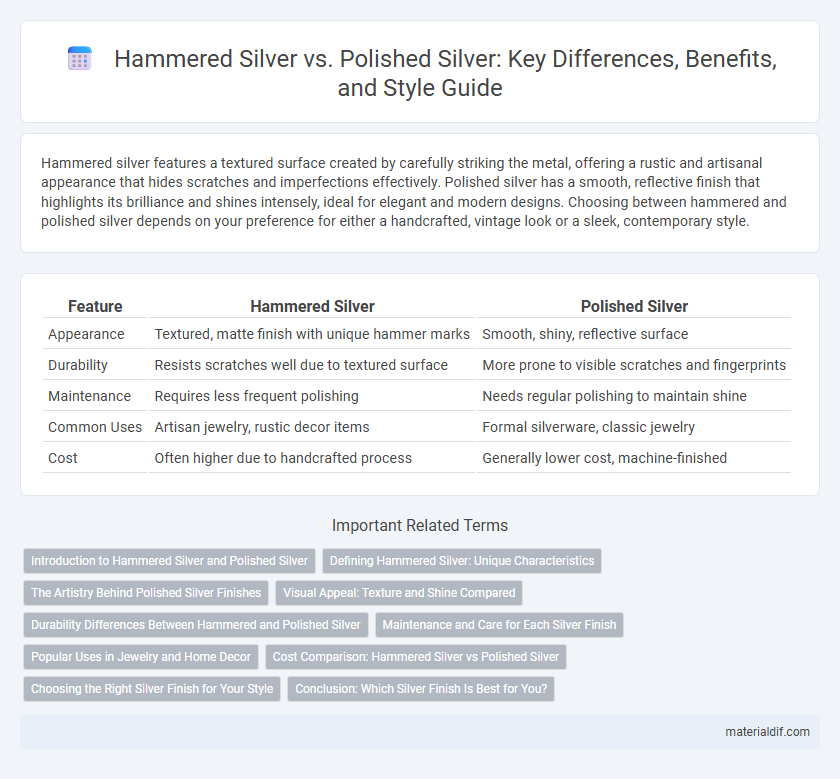Hammered silver features a textured surface created by carefully striking the metal, offering a rustic and artisanal appearance that hides scratches and imperfections effectively. Polished silver has a smooth, reflective finish that highlights its brilliance and shines intensely, ideal for elegant and modern designs. Choosing between hammered and polished silver depends on your preference for either a handcrafted, vintage look or a sleek, contemporary style.
Table of Comparison
| Feature | Hammered Silver | Polished Silver |
|---|---|---|
| Appearance | Textured, matte finish with unique hammer marks | Smooth, shiny, reflective surface |
| Durability | Resists scratches well due to textured surface | More prone to visible scratches and fingerprints |
| Maintenance | Requires less frequent polishing | Needs regular polishing to maintain shine |
| Common Uses | Artisan jewelry, rustic decor items | Formal silverware, classic jewelry |
| Cost | Often higher due to handcrafted process | Generally lower cost, machine-finished |
Introduction to Hammered Silver and Polished Silver
Hammered silver features a textured surface created by manually striking the metal with a hammer, resulting in a unique, rustic appearance that enhances light reflection. Polished silver undergoes a smoothing and buffing process to achieve a sleek, mirror-like finish, highlighting its bright and shiny qualities. Both finishes offer distinct aesthetic appeals, with hammered silver emphasizing artisanal craftsmanship and polished silver showcasing refined elegance.
Defining Hammered Silver: Unique Characteristics
Hammered silver features a distinctive textured surface created by manually striking the metal with a hammer, resulting in a dimpled, organic appearance that enhances light reflection and adds depth. This handcrafted technique produces a unique, artisanal aesthetic that contrasts with the smooth, reflective finish of polished silver, emphasizing individuality in each piece. The irregular pattern of hammered silver often increases durability by disguising minor scratches and imperfections, making it both functional and visually appealing.
The Artistry Behind Polished Silver Finishes
Polished silver finishes showcase meticulous craftsmanship, achieved through expert buffing and multiple stages of fine sanding to create a mirror-like surface that enhances the metal's natural luster. This artisanal process requires precision to eliminate imperfections while preserving the integrity and malleability of the silver alloy, often Sterling Silver (92.5% pure). The result is an elegant, reflective finish prized in luxury jewelry and fine tableware, contrasting the rustic, textured appeal characteristic of hammered silver.
Visual Appeal: Texture and Shine Compared
Hammered silver features a textured surface with irregular indentations that create a matte, rustic finish, enhancing its artisanal and handcrafted appeal. Polished silver boasts a smooth, highly reflective surface that offers a bright, mirror-like shine, lending an elegant and contemporary look. The contrast between hammered and polished silver lies in the tactile depth and light reflection, influencing the visual impact and style preference.
Durability Differences Between Hammered and Polished Silver
Hammered silver features a textured surface created by hand-tooling, which enhances its durability by hiding scratches and dents more effectively than polished silver. Polished silver, with its smooth and reflective finish, is more prone to visible scratches and requires frequent maintenance to retain its shine. The hammered texture also strengthens the metal, making hammered silver a more resilient option for everyday use.
Maintenance and Care for Each Silver Finish
Hammered silver requires gentle cleaning with a soft cloth to preserve its textured surface and prevent damage to its unique dimples, while avoiding abrasive materials that could dull its appearance. Polished silver needs regular polishing with a silver-specific cleaner to maintain its high shine and prevent tarnish from building up, often benefiting from proper storage in anti-tarnish cloth or bags. Both finishes should be kept away from harsh chemicals and moisture to prolong their lifespan and keep the silver looking pristine.
Popular Uses in Jewelry and Home Decor
Hammered silver features a textured, dimpled surface that enhances its rustic charm, making it popular in artisan jewelry like rings, bracelets, and pendants for a handcrafted aesthetic. Polished silver offers a smooth, reflective finish favored in elegant jewelry pieces such as necklaces and earrings, as well as sleek home decor items like picture frames, candle holders, and silverware. Both finishes cater to distinct styles, with hammered silver appealing to bohemian and vintage trends while polished silver suits modern and classic designs.
Cost Comparison: Hammered Silver vs Polished Silver
Hammered silver typically costs more than polished silver due to the additional labor-intensive process involved in creating its textured surface. The handcrafted nature of hammered silver increases production time, which raises its price compared to the smoother, machine-finished polished silver. Polished silver benefits from streamlined manufacturing, resulting in lower costs and often more affordable retail prices.
Choosing the Right Silver Finish for Your Style
Hammered silver offers a textured, artisanal appearance that enhances vintage or rustic jewelry, while polished silver provides a sleek, reflective surface suited for modern, minimalist designs. Choosing the right silver finish depends on personal style preferences and the type of accessory, with hammered silver adding depth and character, and polished silver emphasizing elegance and shine. Consider the occasion and outfit pairing to determine whether the understated charm of hammered silver or the crisp brilliance of polished silver best complements your look.
Conclusion: Which Silver Finish Is Best for You?
Hammered silver offers a textured, artisanal look that hides scratches and wear, making it ideal for everyday jewelry or decorative items. Polished silver provides a smooth, reflective surface that highlights elegance and sophistication, perfect for formal occasions and high-end accessories. Choosing between hammered and polished silver depends on your style preference and the item's intended use, balancing durability with aesthetic appeal.
Hammered Silver vs Polished Silver Infographic

 materialdif.com
materialdif.com